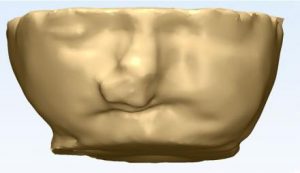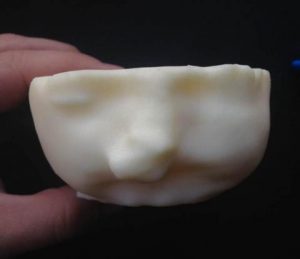3D-printed head helps save baby's life
When a pregnant woman's ultrasound revealed a lump on her unborn baby's face, doctors turned to 3D printing to figure out what the next steps were.
3D printing is opening the doors to a plethora of medical breakthroughs. Recently, doctors from the University of Michigan were able to reap the benefits of the technology and save a baby’s life.
When Megan Thompson was 30 weeks pregnant, an ultrasound showed a walnut-sized lump on her unborn child’s face. Doctor’s speculated that this deformity might mean the baby wouldn’t be able to breathe once he or she was born.
Thomspson was referred to the University of Michigan’s C.S. Mott Children’s Hospital where doctors needed to determine whether the baby could be delivered via C-section or needed a rare and complex lifesaving procedure. How did they figure it out? Using 3D-printing technology.

How they did it
The doctors used a specialized MRI of the fetus in the womb and then used a 3D printer to print models of the fetus’ face in order to help determine where and how dangerous the soft tissue mass was.
“Based on the images we had, it was unclear whether the mass would block Conan’s airway after birth. The 3D printed model of the fetus allowed us to actually see in person what it looked like and have something in our hands to help us decide the best way to care for the baby,” said Glenn Green, M.D., associate professor of pediatric otolaryngology at U-M’s C.S. Mott Children’s Hospital.
According to Dr. Green, this is the first time that 3D printing has been able to display the severity of an airway risk in a fetus and help doctors make medical decisions.
“3D printing may be an incredibly valuable tool to help doctors prepare for complex cases ahead of birth,” said Dr. Green.

The information extracted from the 3D-printed models helped doctors determine that Conan would not need the special surgery, called Ex Utero Intrapartum Treatment Procedure (EXIT), which requires a partial delivery of the baby while it remains attached by its umbilical cord to the placenta so that a surgeon can establish an airway to allow the baby to breathe. Instead, Conan was born via scheduled C-section.
“They told me the 3D printed models would help give them a more accurate idea of what was going on and what kind of delivery I should have. I was relieved that I didn’t need the more complicated and risky surgery and could be awake for the birth of my first baby. I’m glad that what they did for Conan may help other babies and their families in similar situations,” said Thompson.
This isn’t the first time doctors from the University of Michigan used 3D printing to save a baby’s life. They also used 3D printed splints to help save the lives of babies with severe tracheobronchomalacia, which causes the windpipe to periodically collapse and prevents normal breathing.







